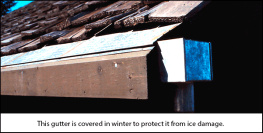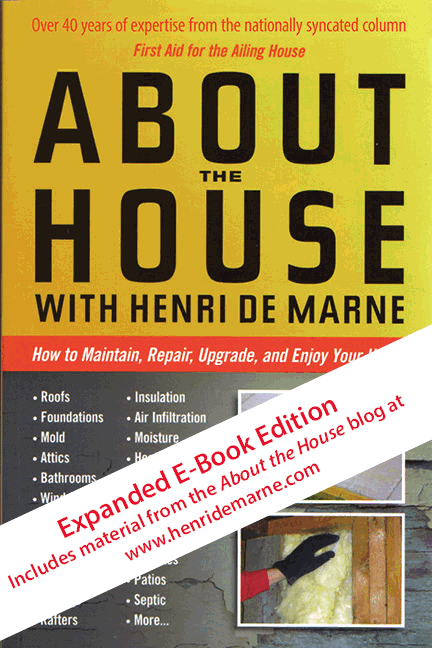All rights reserved. Brief quotations for review or analysis are welcomed, as long as full attribution is included. For permission for longer quotations or other use, please contact the publisher.
Portions of this book have appeared in the original trade-paper edition of the book About the House with Henri de Marne , in the syndicated column First Aid for the Ailing House , and the blog at www.henridemarne.com .
Design and layout by Kitty Werner. The copyright for the title of the newspaper column First Aid for the Ailing House is held by Universal Uclick, formerly United Features Syndicate. Trade names and brand names of products and services referred to in this book are the property of their respective owners. Photographs and other illustrations, unless otherwise identified, are by Henri de Marne, Kitty Werner, or Peter Werner.
Introduction
This book is the result of 40 years of conversations with readers throughout the U.S. and Canada, in more than 6,000 newspaper columns and, more recently, my blog at www.henridemarne.com. Some of the readers are competent do-it-yourselfers, while many others seek to generally understand a problem in order to hire the best contractor to fix it or to determine whether its even worth fixing.
Some of the questions are extremely serious and come up again and again covering important issues such as the damage caused by improper grading around a foundation, inadequate vapor barriers, incorrect venting, or termites and other pests. Some readers have asked for general advice, such as the best choices for heating and cooling or the longest-lasting siding materials. Others have specific questions, such as how to remove mirror tiles that are glued to a wall or how to get rid of moss or mold on the north side of a roof.
It sometimes seems like every possible issue involving houses has been covered from every angle, yet readers continue to provide me with fresh material to write about every week. Houses are complex systems, so there are always new issues and new angles to discuss. Thats what makes my job as a columnist and blogger enjoyable and challenging.
A book has one significant advantage over a newspaper column and blog site it can combine a lot of information that is readily available at the time its needed. When your plaster ceiling suddenly starts sagging, or your radiator mysteriously stops heating up, or you find specks all over your aluminum siding that you cant wash off, you may not remember the information from the last time you read about it in the newspaper or on line. Now, you can easily look up the answers whenever you need them.
In any event, I hope youll enjoy browsing through the book to learn more about the house you live in, and that youll keep it handy as a reference for repairs, maintenance, and improvements.
Foundations, Basements, Crawl Spaces
Foundations take many forms, including full basements, piers, slabs, and crawl spaces. They need to be strong enough to hold up the structure, built on solid ground to avoid sinking or shifting, and protected from frost, soil and water pressure. They should be constructed in ways that help keep the house comfortable, and, when possible, provide extra space for living and for storage.
Much can go wrong with a foundation. But as you read through this chapter, youll see that similar problems keep repeating themselves: the foundation backfill is improperly done; the soil around a foundation is not properly graded or drained; the concrete is not properly cured; incorrect methods and materials are used for insulating, painting, and other finish work. Repetition is necessary because these problems manifest themselves in many ways.
Foundations for New Houses and Additions
The best time to avoid problems with foundations is while they are built. Its much easier and less expensive to avoid moisture problems, in particular, with proper design than it is to fix them later. And if mistakes are made, its probably easiest to fix them (and perhaps to hold the contractor accountable) when the house is new. The most common serious mistakes are improper backfilling of the excavation, including provisions for a working and long-lasting drainage system and grading of the soilwhich should always slope away from the house. There are also unique problems with new foundations. They include taking precautions for proper curing of poured concrete walls or choosing the right size concrete blocks for the depth of the excavation (too often, 8-inch blocks are used for foundation walls deeper than 5 feet). Once built, other problems are related to moisture in the concrete walls and floor of a basement, which may take as much as two years to dry and can cause considerable moisture problems in the living quarters.
Design of a walk-out basement
Q. I am building a house this summer. It will have a walk-out basement, which will be finished with living space. Do both sides of the concrete foundation need to be insulated? Should footing drains be on the inside and outside of the footings? What is the sequence of materials for the drain: Does the fabric go down, then the stones, the drain pipe and sand? What kind of fill do I need to backfill with to make sure my concrete walls dont crack? What is the ideal distance from the top of the concrete wall to grade? Do I need at least 4 feet of concrete below grade?
A. Lets start at the beginning. Frost walls should be below the frost line of the area where you are building. The recommended practice in your climate (Northeastern U.S.) is to have frost walls a minimum of 4 feet deep below grade. It is best to have about 1 foot of the foundation above final grade but you must plan for the final grade to slope away from the house by 2 inches per horizontal foot. Concrete walls can be insulated from the outside or the inside; there is no need to do both.
Drain pipe should be installed next to the footings and not on top of them. The best procedure is to lay a 4-foot-wide band of geotextile (filter) fabric against the excavation wall (pin it with 16-penny nails) and place 2 inches of egg-size stones in the bottom of the trench. (If stones are expensive or hard to get in your area and recycled rubber tire chunks are available, they are a better alternative anyway.)
Now lay perforated pipe, holes down, over the stones; place at least another foot (preferably 18" or more) of stones over the pipe; fold the fabric over the stones bringing it up against the foundation walls and tape it to them to hold it in place until further backfilling.
Complete the backfilling with coarse sand or bank-run gravel to within a foot of what has been determined as the finish grade to ensure good drainage and protection against frost pressure. Complete the grading with topsoil. The only time it is advisable to install footing drains inside the foundation as well is if there is a seasonal high water table or very heavy soil.













